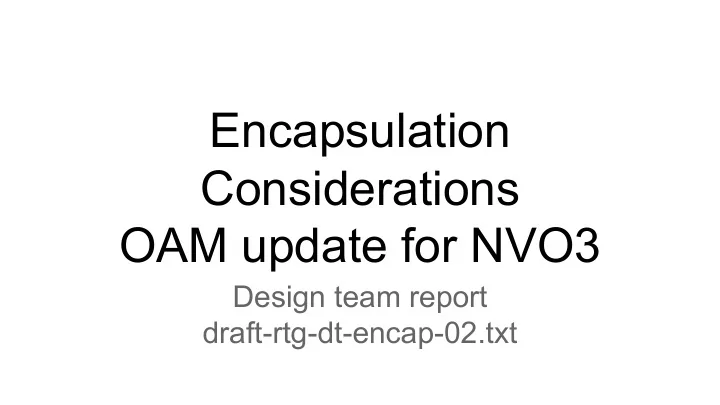

Encapsulation Considerations OAM update for NVO3 Design team report draft-rtg-dt-encap-02.txt
Packet size and fragmentation ● Deployed overlays assume underlay MTU ○ Reasonable for controlled deployments in datacenter or SP networks ● But useful to detect misconfiguration ○ Set outer don’t fragment (DF) flag ○ Syslog received ICMP “packet too big” on NVE ○ Also generate overlay ICMP PTB for IPv4/6 ● Other encaps could do frag/reassembly ○ NVO3 deployed outside of its original environment? 2
OAM [Repeat] ● Discussed in NVO3 and SFC and LIME ○ Rich architectural discussion ○ We only looked at effect on encaps format ● Need for in-band OAM measurements ○ Add measurement info to data packets ● Out-of-band measurements ○ OAM packets follow same path as data packets ○ Assumes same ECMP, QoS, middlebox/firewall ○ Constrains entropy use in forwarding routers 3
OAM support [Repeat] ● Avoid sending OAM frames to end stations ○ Use some “discard” next header value, or OAM bit? ● Support in-band OAM measurements ○ Bit for counter sync between ingress and egress ○ Optional timestamps etc in encaps header ● Error Reporting Protocol as part of OAM? ○ How to avoid it being filtered as ICMP often is? ○ Recommend that IETF look into error reporting that is independent of the specific encaps 4
Update in -02 ● Avoid sending OAM frames to end stations ○ The next header value might have other implications ■ E.g., classify IPv4 vs IPv6 vs Ethernet vs. SFC ○ Thus an OAM “drop after decaps” bit seems preferred over a “discard” next header value 5
Recommend
More recommend